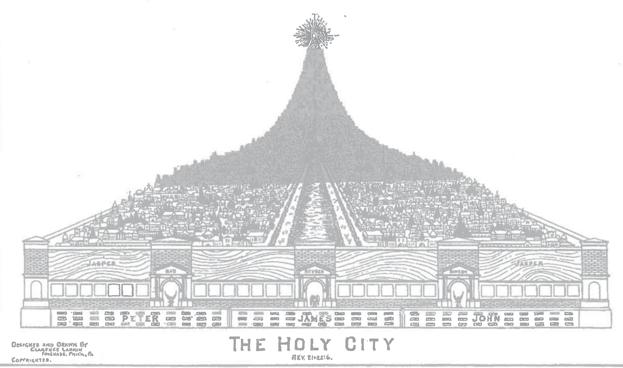Another translation for ‘jasper’ is ‘diamond’ which is clear as crystal. That jasper was also referred to in the description of the ‘One who was sitting on the throne’,2 and that is also translated as ‘diamond’ in some versions. A diamond is colourless and completely clear, but it divides light in all kinds of colours as it passes through it, from red to violet through all the colours of the rainbow. Jasper is a fusion of quartz crystals and can have all kinds of colours, from red to reddish brown, green, yellow and white. John describes the ‘Glory of God’ and the ‘Glory of the City of God’, of the Lamb’s bride, in terms of light and colour. He refers to precious stones in order to indicate the brilliance and the colour, as well as something of the structure, of the building materials of the City. It is like, he says, so that is not what it really is. He is unable to say what it really is, but he grasps the best image out of worldly reality to describe it, to compare it. Jasper is the twelfth stone on the High Priest’s breastplate in Israel.3 Following the description of these stones given in the Authorised Version of the Bible, the twelve stones in that breastplate are: sardius, topaz and carbuncle in the first row; emerald, sapphire and diamond in the second row; ligure, agate and amethyst in the third row, and beryl, onyx and jasper in the fourth row. We shall see a great number of them in the description of the City’s twelve foundations4 where the names of the Lamb’s twelve Apostles are inscribed.5
How should you imagine this descent of the ‘City of God’, shining thoroughly with God’s Glory, in terms of ‘space’? The description does not enable us to know whether this great, big ‘City’ with the mass of approximately the same size as the moon (albeit with a different shape and form) descends upon the New Earth. It is possible, and this could also possibly mean, that the New Earth will be of far larger size than our present planet. But, in itself, that is not necessarily the case. It can appear as a ‘cube’ with ‘ribs’ of some three thousand kilometres, or a pyramid-shaped mass with a square base of three thousand kilometres on each side and three thousand kilometres high. The designer of the cover of this book in the first copies – of the 11 printings that this book has gone through in the Netherlands
– has opted for the form of a cube, but he would have been just as right to choose the pyramid form, which you often come across in other, especially older commentaries on the Book of Revelation. It is apparently a ‘City’ with a square base, surrounded by high walls of a hundred and forty-four el—that is, some 70 metres high. My preference would tend towards the pyramidal form. That looks a little more like a ‘city’ than a ‘cube’! And the pyramidal form is also particularly suitable to break the Light of God’s Glory into the many colours of the rainbow. The diagram below is a picture from one of these older old commentaries on the Book of Revelation. It is a ‘City’ built on the sides of a mountain, the foot of which is surrounded by high walls. God dwells on Mount Zion. He reveals Himself on Mount Sinai. ‘Babylon’ was built on seven hills, but ‘Jerusalem’ is a city on a mountain. What is most important of all is the fact that the ‘Glory of the Lord’ lights up the whole of the City. “I did not see a Temple in the City, because the Lord God Almighty and the Lamb are its Temple. The City does not need the sun or the moon to shine on it, for the Glory of God gives it light, and the Lamb is its lamp…There will be no more night. They will not need the light of a lamp or the light of the sun, for the Lord God will give them light. And they will reign for ever and ever.”
That is why the pilgrims went up to Jerusalem: singing the ‘Psalms of the Ascent’, which is a collection of 15 Psalms: Psalm 120-134. The generally accepted view is that the Hebrew term ‘maʿalot’ (goings up) is a reference to pilgrims going up to Jerusalem for the three required festivals. “That is where the tribes go up— the tribes of the LORD— to praise the Name of the LORD according to the statute given to Israel.”6 Those who trust in the Lord are like Mount Zion, which cannot be shaken but endures forever. As the mountains surround Jerusalem, so the Lord surrounds His people both now and forevermore.7 Jesus says: “Ye are the light of the world. A city that is set on a hill [mountain] cannot be hidden.”8



